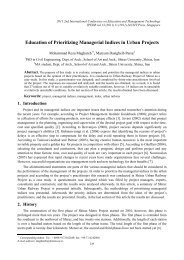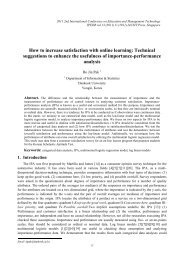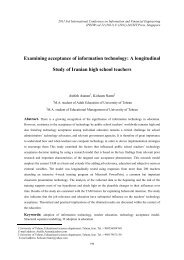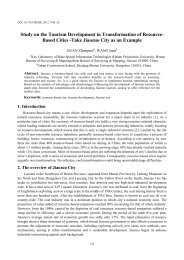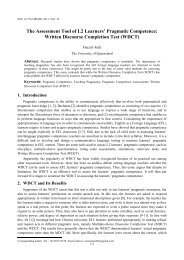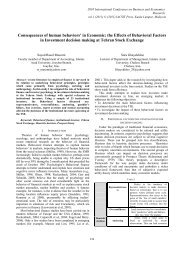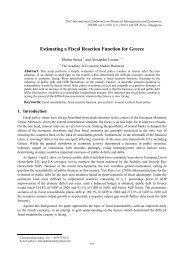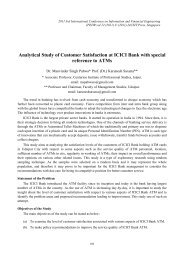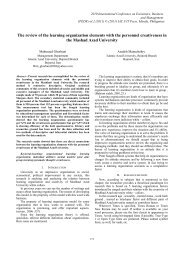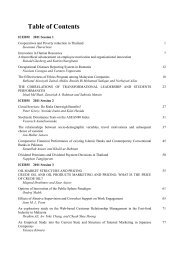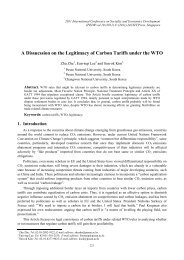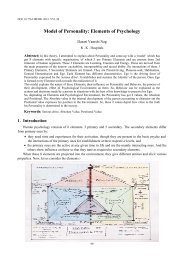Aeta Mag-anchi's Cultural History, Concept of Time and ... - ipedr
Aeta Mag-anchi's Cultural History, Concept of Time and ... - ipedr
Aeta Mag-anchi's Cultural History, Concept of Time and ... - ipedr
You also want an ePaper? Increase the reach of your titles
YUMPU automatically turns print PDFs into web optimized ePapers that Google loves.
word “Negro” meaning dark skinned. In the world<br />
ethnographic literature, at present, they are more popularly<br />
known as Negrito Pygmy. Approximately, the Negrito<br />
Population throughout the Archipelago is roughly 90,000<br />
(NCCP-Pact) they are divided into 25 ethnolinguistic groups<br />
dispersed in b<strong>and</strong>s form Luzon to Mindanao. The most<br />
numerous are those found in the isl<strong>and</strong> <strong>of</strong> Luzon<br />
(Encyclopedia <strong>of</strong> Phil. Arts, Vol. 1, 1994)<br />
Barrows (1910) further explained that the Negrito is a<br />
scattered survivor <strong>of</strong> the pygmy Negro race, at one time<br />
undoubtedly far more important <strong>and</strong> humerous;<br />
brachycephalic, platyrhinian, wooly headed, <strong>and</strong> when<br />
unaffected by the higher culture are forest dwellers.<br />
The <strong>Aeta</strong> <strong>Mag</strong>-anchis belong to this group <strong>of</strong> indigenous<br />
people who inhabit mostly the highl<strong>and</strong>s or mountain regions<br />
<strong>of</strong> the Pampanga - Tarlac area in the Philippines; they have<br />
preserved their ethnic identity through their language, belief<br />
system <strong>and</strong> consciousness. Suitably adapted to their<br />
ecological niche <strong>and</strong> environment, the <strong>Aeta</strong> communities still<br />
employ subsistence patterns practiced by their forebears,<br />
such as hunting, foraging, <strong>and</strong> swidden cultivation. In precolonial<br />
times, their ancestors inhabited the valleys <strong>and</strong><br />
ridges <strong>of</strong> the Pinatubo Area, but were driven into the<br />
interiors when the western colonizers came. (Cojuangco)<br />
Their practice <strong>of</strong> swidden cultivation differentiates the<br />
<strong>Aeta</strong> mag-anchis from other aetas in the sense that they do<br />
not consider themselves as nomadic. Their movement is<br />
only limited within a certain radius in areas which they<br />
consider as a part <strong>of</strong> their territory because they have been<br />
cultivating it.<br />
Swidden cultivation further supports their establishment<br />
<strong>of</strong> settlements usually located at the center <strong>of</strong> their swidden<br />
sites. Since this is their main source <strong>of</strong> livelihood, they are<br />
so much dependent on seasonal <strong>and</strong> ecological changes<br />
which further affects their time management. Unlike the<br />
mainstream western acculturated Filipino who is dependent<br />
on linear time, the <strong>Aeta</strong> <strong>Mag</strong>-<strong>anchi's</strong> concept <strong>of</strong> time is based<br />
on their consciousness despite the presence <strong>of</strong> clocks that<br />
measures linear time.<br />
Territorial boundaries were never defined by the <strong>Aeta</strong>s in<br />
terms <strong>of</strong> concrete boundaries. Again, this is based on their<br />
consciousness <strong>and</strong> is defined with the use <strong>of</strong> markers such as<br />
fruit trees <strong>and</strong> natural demarcations such as rivers <strong>and</strong> ridges,<br />
whatever is present in the area.<br />
Linguistically, the Summer Institute for Linguistics have<br />
identified the <strong>Aeta</strong> <strong>Mag</strong>-anchis as those <strong>Aeta</strong>s living at the<br />
slopes <strong>of</strong> Pinatubo particularly on the Pampanga-Tarlac Area.<br />
<strong>Aeta</strong> mag-anchi as stated by Storck (1991) is a dialect<br />
prevalent among those <strong>Aeta</strong> groups which the SIL have said<br />
to be unique among these people. It is different from the<br />
<strong>Aeta</strong> Zambal spoken by the Abenlen (Abelling) <strong>Aeta</strong>s since<br />
it is Capampangan based <strong>and</strong> the emphasis on the persistent<br />
use <strong>of</strong> the glottal stop among speakers <strong>of</strong> the dialect.<br />
Historically, these <strong>Aeta</strong> <strong>Mag</strong>-anchis have been exposed<br />
to an early acculturation process brought about by the<br />
Spanish Catholic missions in the Bamban area as cited in<br />
early Spanish documents.<br />
During the American regime, they were considered as a<br />
"cultural minority" because they did not easily succumb to<br />
V2-114<br />
the changes that the Americans were implementing. Among<br />
the Filipino Majority population in the area, acculturation<br />
process was made possible through the introduction <strong>of</strong><br />
formal education but the aetas were not educated formally<br />
due to the persistent practices <strong>of</strong> their age old practices.<br />
<strong>Time</strong> to us lowl<strong>and</strong>ers generally can be measured by a<br />
clock, thus translated one day is 24 hours, one hour is 60<br />
minutes <strong>and</strong> one minute is 60 seconds. Through such<br />
measurement, we know when to eat our breakfast, lunch, or<br />
dinner. We know the concept <strong>of</strong> being late because we have<br />
the technological awareness. We have time for going to<br />
work, to school, to rest <strong>and</strong> to sleep. We have a<br />
measurement <strong>of</strong> our age because we know that there are 30<br />
days in a month <strong>and</strong> 12 months or 365 days in a year. More<br />
or less we are bounded by schedules that are stuck around<br />
time. We are made constantly aware <strong>of</strong> it because <strong>of</strong> the<br />
technology called clock thus making us conscious <strong>of</strong> time.<br />
Without the clock, time for us could be measured through<br />
two points in a distance. Thus, we can never give the exact<br />
elapsed time from one point in space through another but<br />
instead we state that approximately the distance for example<br />
from one house to another is measured through number<br />
steps rather than the number <strong>of</strong> minutes.<br />
Our awareness <strong>of</strong> our age can only be made possible<br />
through our awareness <strong>of</strong> seasons because it will be difficult<br />
to remember the number <strong>of</strong> nights that you have slept in as<br />
you grow older without the calendar. Thus, our awareness <strong>of</strong><br />
our past is bounded by material correlates such as the<br />
calendar <strong>and</strong> the clock. Without such, people have to contend<br />
with whatever it is that the group will be able to<br />
institutionalize as time measurement through historical<br />
experience. To a western oriented perception, a person has a<br />
great preoccupation with records, diaries, calendars, time<br />
graphs, etc. To an <strong>Aeta</strong> mag-anchi this clock consciousness<br />
is not present. While the western orientation marks time<br />
with a calendar or watch, the <strong>Aeta</strong> <strong>Mag</strong>-anchi marks time<br />
with his consciousness. Thus, the <strong>Aeta</strong> remembers the past in<br />
terms <strong>of</strong> consciousness <strong>and</strong> not in terms <strong>of</strong> linear time.<br />
Their concept <strong>of</strong> time <strong>and</strong> territoriality which is both tied<br />
to their consciousness largely affect their worldview as a<br />
people. Historical consciousness affects the identity <strong>of</strong><br />
people. Hence, common historical experience molds<br />
common identity (Shimizu, 1989). However, since the aeta<br />
concept <strong>of</strong> time is not the same as the mainstream<br />
westernized Filipino, a vacuum exist in their historical<br />
experience as a people. Meaning, there is no collective recall<br />
<strong>of</strong> the past based on chronological account. Which makes our<br />
historical experience different from theirs. This is further<br />
affected by the fluidity by which they perceive time. In turn,<br />
education is seen to be a vehicle in molding the historical<br />
identity <strong>of</strong> people. Historical consciousness is passed<br />
through generation through learning. However, to an aeta<br />
<strong>Mag</strong>-anchi, the absence <strong>of</strong> historical consciousness means<br />
their inability to maintain structures that would transmit<br />
historical learning through succeeding generation. Education<br />
to an <strong>Aeta</strong> <strong>Mag</strong>-anchi is focused only on the ability to<br />
maintain day to day survival techniques rather than an<br />
institution which could transmit historical consciousness as a<br />
people.



